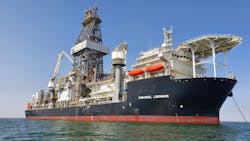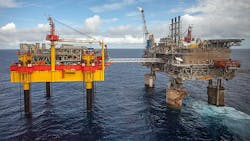CENTRAL/SOUTH AMERICA
BW LNG and Inveneregy have secured over $128 million from IDB Invest to finance the purchase and conversion of an LNG carrier into El Salvador’s first floating storage and regasification unit. The vessel, with a re-gas capacity of 280 MMcf/d and an LNG storage capacity of 4.8 MMcf (137,000 cu m) will be moored at Acajutla Port, Sonsonate. The re-gasified LNG will be transported through a subsea pipeline to a 378-MW power plant onshore: the project, due to be completed next year, should supply 30% of the country’s energy needs.
***
First oil has flowed from BHP’s shallow-water Ruby project in block 3a within the Greater Angostura field offshore Trinidad and Tobago. Five production wells and one gas injector in the Ruby and Delaware reservoirs will deliver at peak up to 16,000 b/d of oil and 80 MMcf/d of gas.
***
ExxonMobil and its partners have achieved another commercial discovery in the prolific Stabroek block off Guyana. The Uaru-2 well, drilled in 5,659 ft (1,725 m) of water by the drillship Noble Don Taylor, penetrated 120 ft (36.7 m) of good-quality oil-bearing reservoirs, including newly identified intervals below the Uaru-1 discovery well, 6.8 mi (11 km) to the north. With more than 9 Bboe now proven across the block, ExxonMobil sees potential for up to 10 FPSOs, and six projects online by 2027.
***
Petrobras has agreed to acquire bp’s interests in six ultra-deepwater blocks in northern Brazil’s equatorial margin region, all awarded in 2013 under the ANP’s 11th bidding round. The concessions are 75 mi (120 km) from the state of Amapa: Petrobras also has an agreement to take on Total’s operated stakes in the blocks, pending ANP approval.
In the presalt Santos basin off Brazil’s south coast, the company is pressing ahead with plans to raise production from the giant Búzios field above 2 MMboe/d by the end of the decade. It has contracted Keppel Shipyard to build the field’s seventh FPSO, due to be delivered in 2024. This will be connected to six producer and seven injector wells via a network of rigid and flexible pipelines, and with capacity to process 180,000 b/d of oil and 7.2 MMcm/d of gas. In addition, Petrobras is inviting bids for a ninth floater, P-80, designed to handle 225,000 b/d and 12 MMcm/d.
***
The Falkland Islands government has granted local E&P company Argos Resources an extension to the PL001 license in the offshore North Falkland basin until May 1, 2022. Argos is seeking partners to drill a commitment well, which could test various vertically stacked sandstone prospects of similar age to Harbour Energy’s nearby Sea Lion oilfield.
WEST AFRICA
ADM Energy and Eunisell have agreed to jointly explore opportunities to develop the Barracuda oilfield in swamp/shallow waters in Nigerian offshore lease OML 141. The scope could include an early production system producing 4,000 b/d later this year. With potential to raise output to 23,000 b/d by 2026 by drilling two further wells. A 7.5-mi (12-km) pipeline taking the oil to the Brass Export Terminal could lower opex costs to $12/bbl.
KBR is assisting the development of Nigeria’s first FLNG vessel, a 1.2-MM metric ton/yr (1.32 MMt) facility. The company is responsible for a due diligence review of the pre-FEED, undertaken by Japanese company JGC. UTM Offshore is leading the project in collaboration with a subsidiary of state oil company NNPC, with a stated goal of decarbonization and monetization of Nigerian gas.
***
VAALCO Energy may bring in an FSO at the Etame Marin oilfield offshore Gabon, once the present FPSO contract with BW Offshore expires in September 2022. Omni Offshore Terminals would operate the replacement vessel for up to 11 years: VAALCO estimates capex for the associated field configuration at $40-50 million, with payback of less than three years, and opex savings (compared with the FPSO) of up to $20 million/yr over the life of the new agreement.
***
Total has produced first oil from its Zinia Phase 2 project in block 17, 93 mi (150 km) offshore Angola. The facilities, designed to recover an estimated 65 MMbbl, include nine new wells connected via subsea equipment to the Pazflor FPSO. Production should peak at 40,000 b/d by mid-2022.
Eni has made a further oil discovery in Angolan block 15/06. The drillship Libongos drilled the Cuica prospect in 1,640 ft (500 m) water depth, inside the Cabaça development area and close to the East Hub FPSO Armada Olombendo. The well encountered 38 API oil in Miocene sandstones, with reserves estimated at up to 250 MMbbl. The company has also been discussing with bp a potential combination of their full upstream interests in Angola.
NORTHWEST EUROPE
Equinor plans a $384-million subsea development for the 134-MMboe Askeladd Vest gas-condensate field in the Barents Sea. The project will involve a tieback of a subsea template over the structure to the Askeladd field via a pipeline and umbilical, with production sent 121 mi (195 km) through the Snøhvit pipeline system to the Hammerfest LNG complex on Melkoya Island off northern Norway. Aker Solutions will supply the subsea production system, including template and two christmas trees, with TechnipFMC installing the pipelines via the reel-lay method, and Nexans the umbilical, fiber-optic and power cables. Equinor and its partners are aiming for start-up in the first half of 2024.
***
Worley is providing FEED services to support Phase 1 of Anasuria Hibiscus UK’s Marigold development in the UK central North Sea, comprising the Marigold and Sunflower oil discoveries. Phase 1 involves re-purposing and upgrading of an FPSO, connected to three subsea production wells, to be followed by Phase 2 in late 2022.
In the UK’s Outer Moray Firth region off northeast Scotland, Ithaca Energy has committed to the Stage 2 enhanced oil recovery project, injecting polymerized water into the heavy-oil Captain reservoir with additional subsea wells and new topsides facilities.
***
ONE-Dyas has secured licenses from the Dutch Ministry of Economic Affairs to produce the NO5-A gas field in the Dutch North Sea, 0.9 mi (1.5 km) from the maritime median line with Germany. The platform will be the first in the North Sea to run entirely on wind energy, ONE-Dyas claimed, and could also tie in production from other Dutch and German offshore fields.
BLACK SEA
OMV Petrom and Romanian gas distributor Romgaz are interested in jointly developing proven gas in the Neptun Deep block in the Romanian sector of the Black Sea. If current operator ExxonMobil accepts Romgaz’s offer, OMV Petrom, the sole partner in the block, would take charge. The block includes Domino, Romania’s first deepwater gas discovery.
MIDDLE EAST
Gas production has started from the Raven field offshore Egypt, the third stage of the $9-billion West Nile Delta (WND) project covering five fields across the North Alexandria and Mediterranean Deepwater offshore blocks. The fields have been developed via three long-distance subsea tiebacks to the shore, connecting 25 wells. Raven’s gas is exported to a new onshore processing plant alongside the existing WND complex. Operator bp expects production to potentially reach 900 MMcf/d, with 30,000 b/d of condensate.
***
Petropars will develop the Farzad B gas-condensate field in the Persian Gulf, under a $1.7-billion contract awarded by National Iranian Oil Co. The workscope includes construction and installation of three platforms; drilling eight wells with combined production of 28 MMcm/d of sour gas; and laying of export pipelines for the gas and condensate. The field is 12.4 mi (20 km) from Farsi Island.
ASIA/PACIFIC
Reliance Industries and bp have started operations at the Satellite Cluster gas field, the second of three deepwater developments in the KG D6 block off eastern India following R Cluster, which came onstream last December. Satellite Cluster will produce up to 6 MMcf/d from five wells across four reservoirs in up to 6,069 ft (1,850 m) of water, 37 mi (60 km) from the onshore terminal at Kakinada. All three projects will be connected to existing hub infrastructure.
***
Petronas has declared force majeure on the Yetagun gas field in blocks M12, M13 and M14 off Myanmar, due to subsurface issues that caused production to fall below the technical threshold of the offshore gas processing plant. The company added it was working on intervention issues to restore operations at the field, which had been onstream since 2003.
***
PTTEP has continued its run of recent drilling successes offshore Sarawak, Malaysia, proving gas in the Kulintang prospect in shallow-water block SK438, 67 mi (108 km) from the coast of Bintulu. The company expected to drill a follow-up well on the block, citing potential for a cluster development through nearby infrastructure. Previously the company found oil and gas with its Sirung-1 well in block SK405B, farther out from Bintulu.
Malaysia, via Petronas has formalized a unitization agreement with Brunei Darussalam that allows for joint development of the Gumusut-Kakap and Geronggong-Jahus East fields which overlap the two nations’ maritime boundary. The Shell-operated Gumusut-Kakap field came onstream in late 2014.
***
CNOOC has started gas production from the single-well Liuhua 29-2 field development, 186 mi (300 km) southeast of Hong Kong in 2,460 ft (750 m) water depth. Production is connected via a subsea wellhead to existing facilities serving Liwan 3-1 and other deepwater fields in the South China Sea.
***
Shell is exiting the deepwater Malampaya gas-condensate field after agreeing to sell Shell Philippines Exploration’s 45% operated interest in the surrounding Service Contract 38 for an initial $380 million. The buyer is Malampaya Energy XP, a subsidiary of Udenna Corp, which is already a partner in the concession. The field has been producing since 2002 via subsea wells and flowlines and two platforms, with gas exported through a 313-mi (504-km) subsea pipeline to a gas plant in Batangas City. Shell could net further payments of up to $80 million depending in part on the field’s future performance.
***
Eni has produced first gas from the Merakes field in the East Sepinggan block offshore East Kalimantan, Indonesia, in a water depth of 4,921 ft (1,500 m). Up to 450 MMcf/d from five subsea wells will be gathered at a manifold for transmission 28 mi (45 km) through subsea pipelines to Eni’s Jangkrik FPU; from there, the processed gas heads through further offshore pipelines to the onshore reception facility in Senipah.
AUSTRALASIA
Santos has awarded two of the main contracts for the $3.6-billion Barossa project in the Timor Sea, 186 mi (300 km) from Darwin. BW Offshore will supply the FPSO, based on the RapidFramework design previously applied to the Catcher field FPSO in the UK North Sea that allows for concurrent hull construction and topsides integration. The vessel, with a projected topsides weight of around 35,000 tons, will be built at yards in South Korea and Singapore, with capacity to process 800 MMcf/d of gas and 11,000 b/d of stabilized condensate. It should start operations (also entrusted to BW Offshore) in the first half of 2025, while the condensate will be stored on the FPSO for periodic offloading.
TechnipFMC will provide the subsea production system for the six subsea wells and associated controls. Gas will head through a pipeline connected to the Bayu Undan to Darwin pipeline system that send supplies to Darwin LNG.
About the Author
Jeremy Beckman
Editor, Europe
Jeremy Beckman has been Editor Europe, Offshore since 1992. Prior to joining Offshore he was a freelance journalist for eight years, working for a variety of electronics, computing and scientific journals in the UK. He regularly writes news columns on trends and events both in the NW Europe offshore region and globally. He also writes features on developments and technology in exploration and production.


